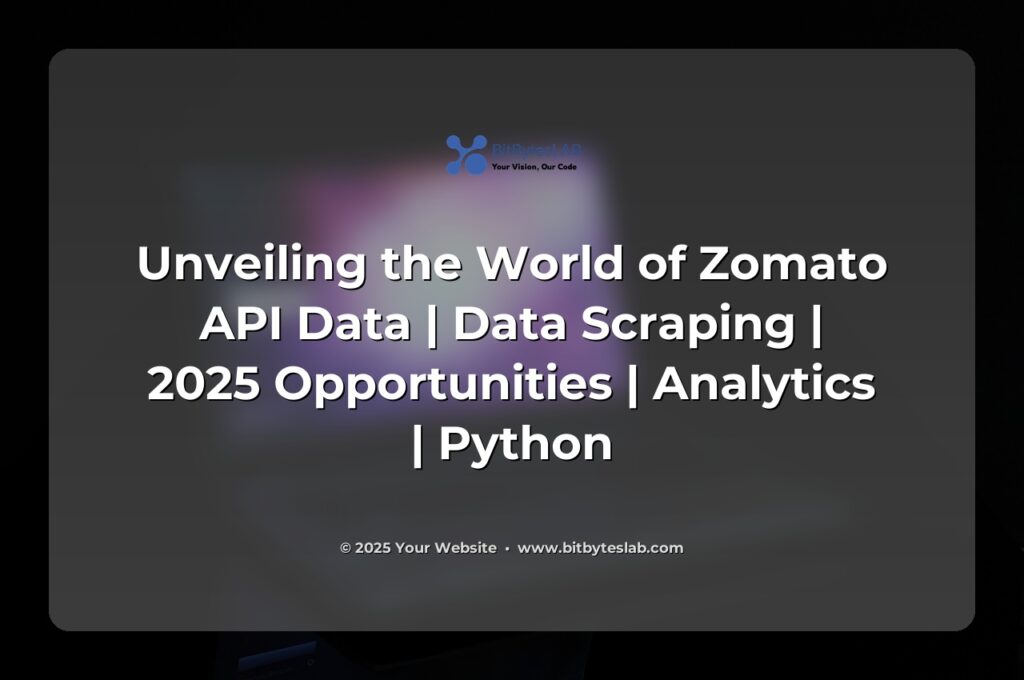Unveiling the World of Zomato API Data | Data Scraping | 2025 Opportunities | Analytics | Python
Picture this: you’re an analytics lead at a food‑tech startup, and the market is buzzing with fresh take‑away options, loyalty programs, and AI‐powered recommendation engines. The secret sauce? Data—raw, granular, and up‑to‑date. Zomato, the king of restaurant discovery in India, holds that treasure trove. In 2025, the way we pull, polish, and profit from that data has evolved dramatically, and it’s time you’re in the know.
From API calls that return clean JSON to clever web scrapers that dig through infinite scrolls, the tools are at your fingertips. Yet, the challenge isn’t the technology; it’s translating that data into actionable insights that fuel growth, cut costs, and keep customers coming back for more. Let’s dive into the real‑world tactics that turned a pile of restaurant listings into a revenue‑generating engine.
What’s the Core Problem?
Restaurant data is vast but often incomplete. The official Zomato API offers structured endpoints, but it’s limited: no deep historical reviews, no granular menu items for older listings, and strict rate limits that can throttle ambitious projects. Meanwhile, the website itself is a goldmine—dynamic menus, user photos, and spontaneous discounts that never make it into the public API. The dilemma? How do you capture every nuance without hitting legal or technical roadblocks?
Core Concepts & Methodologies
At the heart of any data‑driven strategy are these pillars: respectful ingestion (honoring rate limits and robots.txt), dynamic rendering awareness (knowing whether content loads server‑side or client‑side), robust pagination (never missing a row), and clean, schema‑first data models that let analysts and ML engineers get up and running in minutes. Combine that with a layered storage approach—raw, curated, and analytical tiers—and you’ve got a pipeline that outlasts half the tech stack’s life cycle.
For instance, a seasoned data engineer might set up a nightly Airflow DAG that pulls fresh reviews via API, flags anomalies, and pushes them into a BigQuery hub. The same tool can trigger a headless browser job that scrolls through a city’s restaurant page, captures hidden menu items, and archives the HTML for future audits. The key is automation, observability, and, most importantly, ethical sourcing.
💾 There are only 10 types of people: those who understand binary and those who don’t 🔢

Expert Strategies & Approaches
First, start with the official API as your baseline. Its curated fields—restaurant name, cuisine type, rating, coordinates—are clean and consistent. Build a thin wrapper that abstracts pagination and rate‑limit handling. Next, identify the data gaps: perhaps the API stops at the 200th review or excludes menu variations. That’s where dynamic scraping steps in. Instead of brute‑forcing every page, target the specific XHR endpoints that the front‑end calls to fetch JSON payloads. This “API‑inside‑a‑website” method keeps traffic light and data rich.
When you do need to render JavaScript, deploy headless browsers—Selenium, Playwright, or Puppeteer—on serverless runtimes. These tools can execute JavaScript, wait for network idle, and capture a page’s DOM after all widgets have loaded. If your team wants a lower‑maintenance approach, intercept the XHR calls in the browser’s dev tools and reverse‑engineer the API. The result? A single request that returns the exact menu hierarchy you need.
Beyond extraction, data enrichment is where value multiplies. Attach geocodes, sentiment scores from review text, and even image tags from menu photos. Add a timestamped “last‑updated” field so your downstream models always know the freshness of their inputs.
Finally, maintain a raw archive of every JSON or HTML snapshot. Store it in a data lake (S3, GCS, ADLS) with immutable TTL. This gives you a rollback path for compliance audits and a playground for future analytics experiments.
Industry Insights & Trends
Data‑driven restaurants are no longer a luxury—they’re a competitive necessity. In 2025, the global food‑tech market is projected to hit $350 billion, with 60% of that value coming from predictive analytics and personalized offers. Restaurants that leverage real‑time menus and sentiment analytics can tweak prices by up to 5% on average without losing diners—an ROI that speaks directly to the bottom line.
Meanwhile, the shift towards GraphQL APIs means you can request nested menu‑item data in a single call, drastically cutting latency. Bot‑less data pipelines powered by edge computing let you serve fresh insights to mobile apps in milliseconds. And with AI‑driven data cleaning, you can auto‑rectify typos in dish names or flag duplicate listings, ensuring that your dashboards reflect the real market, not a data glitch.
💻 How many programmers does it take to change a light bulb? None, that’s a hardware problem! 💡

Business Applications & ROI
Let’s translate data into dollars. A 1% increase in average order value (AOV)—often achieved by dynamic pricing based on real‑time menu popularity—can translate into an 8% lift in revenue for a mid‑size chain. Combine that with a churn‑prediction model that uses review sentiment and frequency of visits, and you can proactively retain 3–4% of customers per quarter.
Marketing teams can harness real‑time discount data to run hyper‑targeted ad campaigns, lowering cost‑per‑acquisition (CPA) by 12–15%. Meanwhile, supply‑chain managers who ingest menu‑item popularity into inventory algorithms can reduce food waste by up to 20%, directly slashing costs and boosting sustainability scores.
Common Challenges & Expert Solutions
What keeps even seasoned data scientists up at night? IP bans and CAPTCHAs when you hit the site too hard. Mitigate this with rotating proxies, user‑agent rotation, and a polite back‑off strategy. Dynamic content can trip up simple parsers; the answer is to intercept the underlying API calls or use a headless browser that lets the page render fully before extraction.
Another hurdle is data inconsistency—different cities, different formats. Adopt a unified schema early and use validation frameworks (think Pydantic or JSON‑Schema) to enforce it. For legal compliance, always read the most recent terms‑of‑service and robots.txt. If in doubt, reach out to Zomato’s data‑licensing team for explicit permission, especially if you plan to commercialize the data.
Future Trends & Opportunities
Looking ahead, the convergence of AI and data lakes will enable near‑real‑time sentiment analysis and menu recommendation engines that adapt instantly to trending dishes. Serverless scraping** combined with edge computing** will let you scale overnight, turning a one‑time cost into a continually optimized asset. And as privacy regulations tighten, zero‑trust data access**—short‑lived tokens, per‑field encryption—will become the industry standard.
Wrapping It Up
In sum, the Zomato data universe is a well‑spring of potential—if you know how to tap it responsibly and strategically. By blending the official API with dynamic scraping, enforcing clean data pipelines, and aligning analytics with business goals, you can turn raw restaurant listings into a revenue‑driving engine that grows alongside the market. Ready to dive in? At BitBytesLab, we specialize in turning complex data extraction challenges into clean, actionable insights. Let’s build the future of food‑tech together.

